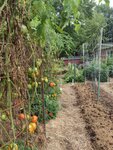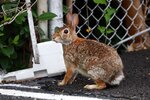 Narrowsburg
NarrowsburgLight Rain Fog/Mist, 43°
Wind: 8.1 mph
 Narrowsburg
Narrowsburg




REGION — If you’re a novice or expert gardener, you’ll probably encounter critters in your garden.
The culprits eating your plants or vegetables are most likely deer, rabbits and insects.
After all the time, money and hard work tending your gardens, it’s normal to feel disappointment when your garden bounty is eaten by something other than humans.
Unfortunately, there are only deterrents, and nothing is foolproof—unless you are lucky enough to have a flat roof to plant upon.
Good bugs vs. bad bugs
Fortunately, many plants that deter rabbits and deer are the same plants that attract “assassin insects.” Predatory wasps, ladybugs and hoverflies (they look like tiny bees, but are harmless to humans) are just a few desirable insects in your gardens. These bugs kill off the bad bugs eating the vegetation, but are not harmful to us.
Toxic relationships
Poisonous plants have been used for generations to buffer the effects of animal browsing. Have you ever seen your tulips disappear, but not your daffodils? Deer and rabbits stay away from daffodils because daffodils are poisonous.
According to the Farmer’s Almanac, “[Animals] avoid eating daffodils, bleeding hearts, foxgloves, and poppies.” All four of those plants are gorgeous as well as poisonous—and flourish in our Zone 5 landscape.

What’s that smell?
Strong odors—and, surprisingly, not just foul ones—are deterrents to furry friends as well as repellent to mosquitoes and flies. Lavender is one such plant that they avoid. Others include salvia, Russian sage, Moonbeam tickseed, Firewitch dianthus and the allium Summer Beauty (not a surprise, since alliums are in the onion family).
The benefits go beyond browse resistance, as those flowers also attract pollinators.
Self-seeding yarrow is not only a rabbit and deer deterrent, but repels some bad insects and attracts good insects.
Do your research, though: Marigolds, said to deter plant lice and mosquitoes, might deter rabbits but they are eye candy, as it were, for deer.

Bodacious and herbaceous
Basil, sage, thyme, dill, coriander, fennel, parsley and caraway are not only tasty herbs, but also attract good insects while deterring rabbits and deer.
Ornamental onions, like the above-mentioned allium, come in a delightful array of colors. They are edible, they self-seed, and they smell yucky to critters.
Planting onions and garlic around/within your gardens might also help. Anecdotally, garlic oil sprayed on plants will repel everything from insects to deer.
You’ve got a friend in bee
Research “companion plants” that bring good insects to fight the bad ones. For example, tomatoes, basil and peppers grow nicely together; the basil’s scent camouflages the scent of the tomatoes and peppers from pests like thrips and moths. Conversely, roses and tomatoes are not good companions.
The trick with herbs, flowers and bulbs— such as garlic and green onions—that attract the good insects and deter furry creatures is to intersperse them along with your garden flowers or garden vegetables and find out what works with what.
Taking the good with the bad
Bob Hoffman, whose Victory Garden is located on Route 652 in Beach Lake, PA, has been gardening all his life. He’s had deer, rabbits, field mice, voles and even bears invading his 6,000-square-foot Edenesque space.
His take on insects and animals is simple: “It’s nature—93 percent of insects are good for your plants.”
What keeps the deer from destroying his garden? He believes it’s the noise from Route 652, but that’s not the end-all solution.
This year, he is experimenting with onions as well as garlic around other vegetables. What also helps is the four-foot-tall fence around the garden. He cleverly attached another four feet of clear plastic fencing, because according to Hoffman, “deer don’t see very well.”
Confuse and conquer is another tactic in the Victory Garden. It’s laid out like a maze. “If the deer jump in, there’s no clear way of getting out,” Hoffman explains. “They want to know there’s a way to exit.”

Good fences make good gardens
Fences definitely aid in deterring deer from eating the edibles. Deer can and will jump fences that are not 10 feet tall or more.
And build under, as well as above, the dirt. To prevent rabbits from tunneling under your gardens, it is suggested to get those fences six inches underground. Plant bushes, flowers, and herbs inside your veggie garden— especially the flowers that invite the good insects in and keep the bad insects at bay.
Poochie pest control
Pets, according to home-improvement show and website “This Old House,” “are extremely helpful for deer management.” The scent and bark of your companion animals naturally deter deer and rabbits.
Coyote urine is sold in stores. Cats run like the wind. And when all else fails, imitate: Rubber snakes and plastic owls can be useful, but have to be moved around your garden regularly to work, as rabbits rapidly learn the dummies are of no consequence. Motion sprinklers, pinwheels and things that move with the wind also deter pests.
Barriers against bucks
Deer and rabbits like smooth-leafed plants and tender shoots from the early growth of trees and bushes. Protect your young trees by encircling them with chicken wire or fencing. Ensure the trunk has room to grow. This prevents bucks from rubbing against trees to mark their territory early in the season and again later in the year to help shed their antlers.

Save your money
Sensor lights do not work. Gadgets that claim to make sounds that only deer, dogs, raccoons, chipmunks etc. can hear—do nothing.
Be aware, if deer are hungry, nothing will stop them—unless you’re a hunter, it’s deer season and you can legally keep them from reaching your garden. As a friend’s grandfather would say, “Time to get the gun.”
Comments
No comments on this item Please log in to comment by clicking here